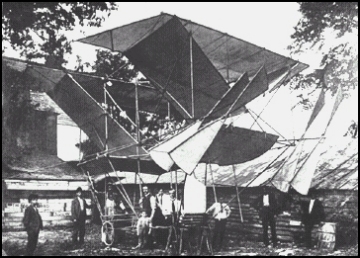
-1960 |
 |
| Ludlow was a New York lawyer who built this large powered craft in 1905. He was determined to get in the air. Unfortunately, he got what he wanted. The crash that occurred after his craft climbed briefly into the skies left him injured for life. |
 |
|
NEW FLYING MACHINE TO BE TESTED TO-DAY The Times did not print many photographs of Ludlow. The two photos on this page originally appeared in Scientific American. In the picture immdeiately above, Ludlow is the dapper gent facing left. The man standing inside the airplane is Hamilton, Ludlow's Aeronaut. Ludlow also appears in the center of the topmost picture, wearing a white shirt and tie. This article comes from the website "To Fly is Everything" A Virtual Museum Covering the Invention of the Airplane Several other articles about Israel Ludlow may be found on the site. In addition, there is a world of fascinating information on aviation to be enjoyed. I highly recommend that you visit it when you have time for a leisurely visit. |
|
In 1907, St. Louis was host to the James Gordon Bennett International Aeronautic Club Race, the "first ever held in the United States." The Trophy, plus a cash prize of $2,500, had been donated in 1906 by James Gordon Bennett, publisher of the New York Herald Tribune, for an annual international long distance balloon race to be conducted by the International Aeronautic Federation. In addition, the Aero Club of America scheduled a competition for the Scientific American Flying Machine Trophy. The memorial, donated by that magazine, was 32 inches high and had been made by Reed and Barton of New York, who valued it at $2,500. The award was to go to the man who could pilot a heavier-than-air machine a distance of one kilometer (3,280 feet) in a straight line, and perform further trials at the descretion of the Aero Club officials. The competition was to be annual, and if anyone could win the event three times in succession, the trophy was to be retired to that person. This contest was to be held on October 24, following the Gordon Bennet Balloon Race (October 21), and the St. Louis Aero Club dirigible (October 22) and "flying machine" (October 23) events. In the competition for the $2,500 heavier-than-air prize, there were seven entrants, at least two of whom had expressed their intention of competing for the Scientific American Trophy as well. They were: the Wixon Aeroplane of H. H. Wixon, Chicago; the Ludlow Aeroplane of Israel Ludlow, Norfolk;the Gammeter Orthopter of H.C. Gammeter, Cleveland; the Flying Machine of J.W. Roshon, Harrisburg, Pennsylvania; the Orthopter of George Francis Meyers, Columbus, Ohio; the Flying Machine Jessie of S. Hemstreet, Chattanooga, Tennessee; and the Orthopter, Milwaukee Number 1, entered by the Vacu-Aerial Navigation and Manufacturing Company of Milwaukee, and operated by Dr. Rudolph Silvester. In additon to these entrants, there were a nmber of contestants who wished to remain anonymous. Of the seven announced entrants, four had relativel orthodox, fixed-wing vehicles, of which Ludlow's was generally representative. It was shaped "like a great box kite" and was launched into the air from a three-wheeled cart, which was used to give it momentum. The dirigible events were the last of the tournament, for there were no airplane flights, either for the $2,500 Aero Club of St. Louis prize of for the Scientific American Flying Machine Trophy. Israel Ludlow and H.H. Wixon of Chicago both brought their primitive "flying machines" to the field, but neither was able to rise from the ground. The trophy and the cash prize were not awarded. The History of Aviation in St. Louis by James J. Horgan, |
|
Information comes to us that Israel Ludlow passed away several years ago, but we have no details. We know that he first flew a glider
in 1905 and in 1906 he was a victim of a glider crackup that left him partially paralyzed. He lived at Mineola, N.Y. and was the subject
of a writeup in the October 26, 1954 issue of Newsday Magazine at which time he was bedridden but still keeping abreast of aviation
progress through reading. January 1960, Number 62 Back 

|